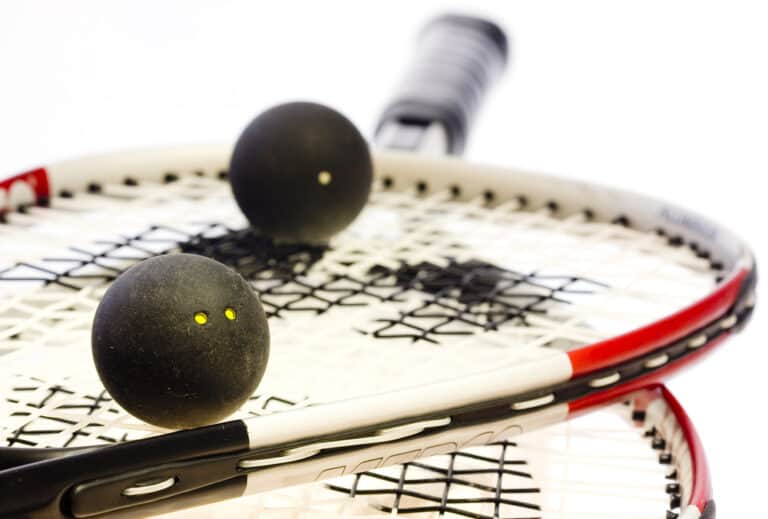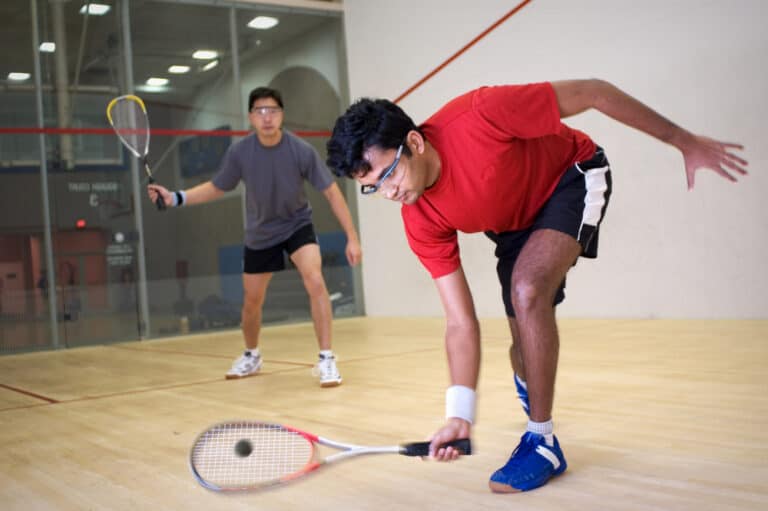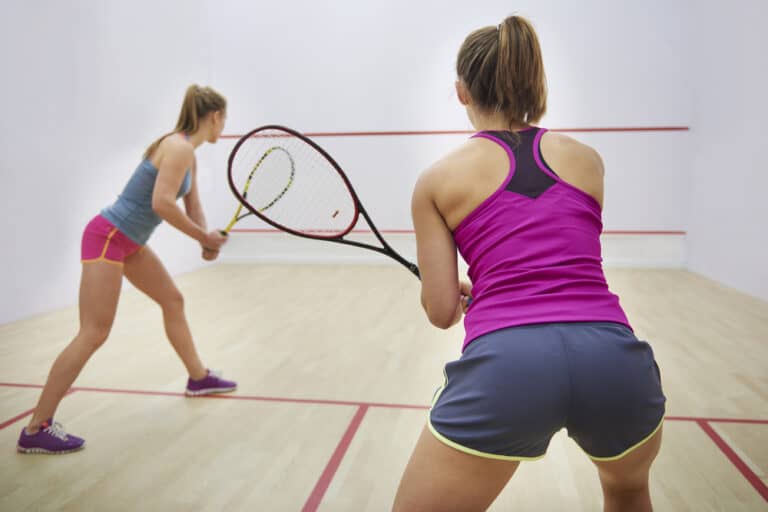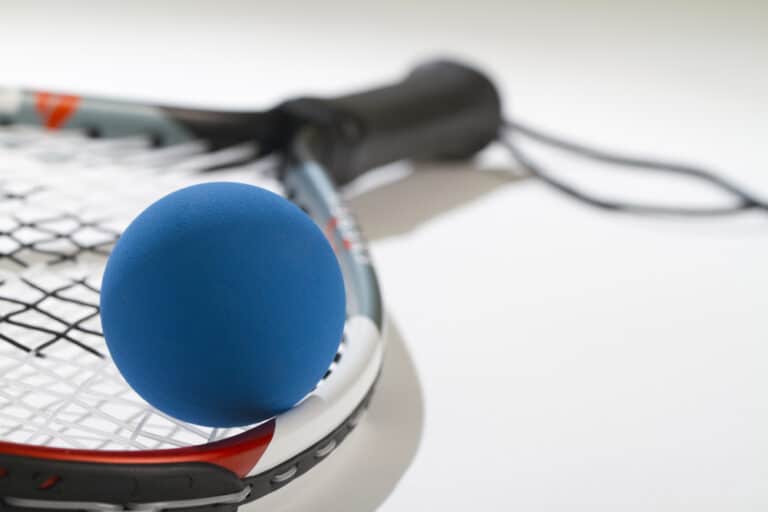What Is A Foot Fault In Squash?
Most racket and ball sports that require a service to commence the point or the game have rules regarding the position of the feet at the time of the serve. Tennis, racquetball, badminton, and other sports like volleyball all have foot fault rules – but what is a foot fault in squash?
A foot fault in squash is called when the serving player does not have one foot inside the red service box, and that foot may not be touching any of the service box lines at the time of the service. The referee may call a foot fault if either of these conditions is not met.
Let’s look at this foot fault call in more detail and understand why it is necessary for squash and other sports, as well as how the foot fault in squash compares to foot faults in other sports.
What Are The Service Boxes In Squash?
Aside from the center line running around the front wall of the court, the service boxes are the most noticeable markings on the squash court.
These boxes are symmetrically placed with one side against the side wall, and the box measures 63″ x63.” What is interesting about the layout is that the width of the squash court is 21′ or 6,4m, and the service box is exactly ¼ the width of the court.
The service boxes are lined by red line marking paint on three sides, with the side wall making up the fourth side.
How To Serve In Squash
To execute a legal serve in squash, the serving player MUST have one foot completely inside the service box and on the ground. The other foot can be outside the box, but the player must have one foot grounded at the time of service.
The ball must hit the front wall of the court and it must make contact between the service line and the out line from the serve, and it must land in your opponent’s quarter of the court. It may hit the side or back wall before landing. This means that jumping serves are not allowed in squash.
When Is A Foot Fault Called In Squash?
A foot fault would be called on the serving player if :
- The serving player’s foot is outside of the service box
- The serving player’s foot is touching one of the service box lines
- The serving player’s foot is not on the ground at the time of the service
Other serving faults can be called, such as if the serving player does not hit the ball after dropping it and the ball hits the floor or part of the player or the ball is served out – above the out-line on the court, or the ball does not land in the opponent’s quarter box.
What Penalty Is Applied For A Foot Fault In Squash?
Unlike tennis, the serving player is allowed only one service, and if the first serve is called a foot fault, the opponent is awarded a point, and the serve is lost.
To avoid losing points and forfeiting the serve, it’s important to know, understand and practice your serve in squash. While foot faults are not often called in squash, players repeatedly violate the rules of serving by having one foot in contact with the lines of the box, and this often goes unnoticed.
It may be because referees in amateur games or recreational players choose to ignore the slight infringements to keep the game flowing. Still, the referees will scrutinize the service in professional tournaments to ensure no violations.
Why Is There A Foot Fault Rule In Squash?
The rules in any game are there to ensure that the game is played fairly, and aside from any athletic advantage, players do not have any edge on their opponent by flaunting rules.
With the serve in squash, having one foot on the line when serving gives the serving player that little extra power and provides the receiver with slightly less time to react to the service and get into position to play it.
The same could be said for having your feet in the air. In tennis, we can see the power that players generate on the ball, and because squash is played on a much smaller court, being able to jump and serve would give the server an unfair advantage.
Another reason for the service rules in squash is that it challenges the serving player to create serves that put the receiving player under pressure, plus it becomes another element of the game that requires development to become proficient.
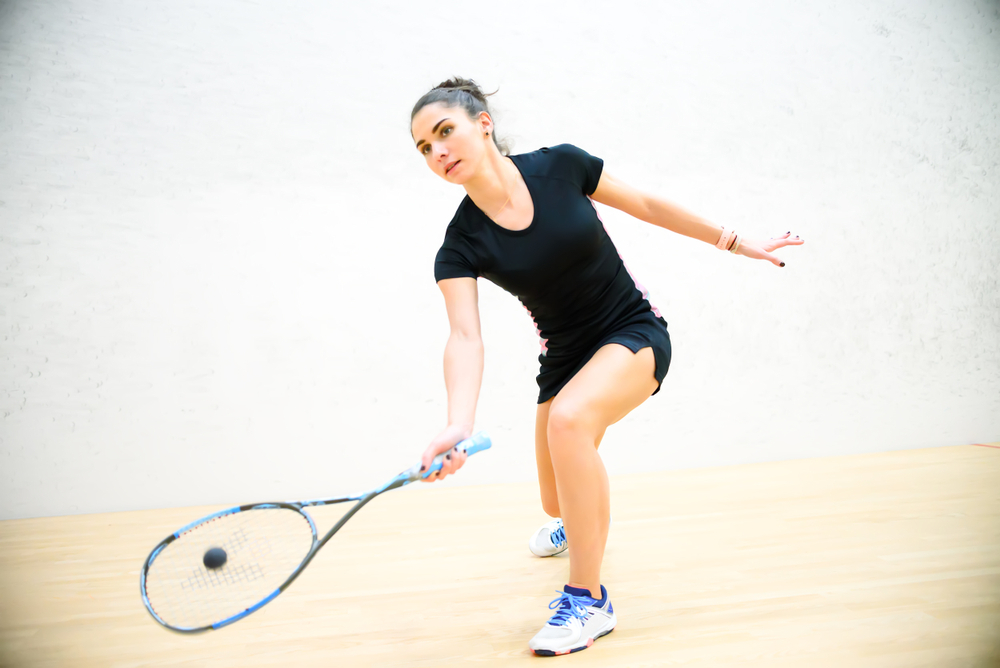
Why Are There Foot Fault Rules In Other Racquet Games?
In sports like racquetball and badminton, foot faults exist for the same reasons as in squash. They prevent players from gaining advantages on serve to either upset the opponent or by gaining more power and speed on the services that would prevent an opponent from a fair opportunity to return it.
Foot Fault In Squash Vs. Tennis
One of the most obvious differences between these two sports when it comes to serving is that in tennis, you can have both feet off the ground when serving, while in squash, you have to have one foot grounded inside the service box.
One common element between tennis and squash is that you may not step on or have part of your foot touching the baseline in tennis when serving, and the same applies to squash- that you cannot have a part of your foot touching the service box lines when you serve.
In each instance, the umpire would call a foot fault, but in tennis, you would get a second serve, while in squash, you would lose the serve, and the opponent would be awarded a point.
In squash, you can have one foot outside the service box without a foot fault being called, but in tennis, both feet must be behind the baseline when serving.
Foot Fault In Squash Vs. Racquetball
Racquetball rules of serve are simpler than those in squash and tennis, and the only rules for serving are that you need to have both feet inside the service box – which is the area defined between the short line and the service line, with the edges bound by the walls of the court.
A foot fault will be called in racquetball if part of your foot, body, or racquet touches the floor beyond the service line – while you can stand on the line, you may not have your foot touching the court beyond that line.
Of course, in squash, no part of your foot may touch any line of the service box, as this would be called a foot fault.
Another rule is that you may not cross the service line until the ball has crossed the short line; if you do, this would be called a foot fault. In squash, once you have hit the ball, you can move to the ‘T’ area or center area of the court without penalty.
In squash, the ball may not touch the ground before the service is executed, as this would be called a serving fault, but in racquetball, the ball must bounce once before it is served and cannot be hit on the volley.
Foot Fault In Squash Vs. Badminton
Badminton foot faults are similar to those in tennis and squash in one respect: the feet may not touch the line when serving.
But badminton has another foot fault rule: the feet may not move during service. In squash, the leading foot can be stepping forward as you serve, and provide one foot is grounded and inside the service box and not touching any part of the line, the service would be legal.
The Foot Fault In Squash Reduces The Chance Of An Ace
Tennis is probably the only racquet sport where aces are actively pursued and able to be achieved and can be used as an offensive weapon, while they serve in sports like squash, and badminton is more for starting the point or the game than scoring points.
Because you have to have one foot inside the service box and be grounded without touching any part of the service box line on a serve in squash, the potential to score an ace from a serve in squash is limited. Most serves are returned if your opponent misses the ball or hits it foul.
The ability to jump in tennis when serving, especially on a first serve, increases the potential for an ace, but in squash, badminton, and racquetball, the limit on foot movement hampers the server’s chances of serving an ace.
Without the foot fault rules, the serve in squash would become the focus, so the return of the serve in squash is the more skilled shot.
Even though the server would look to place the ball in a position that is difficult to return, such as tight to the wall or low off the back wall, the squash serve more about skill in ball placement, subtlety, and disguise than power.
Without the option to jump or create momentum by stepping outside the service box, the server in squash has to develop a specific skillset around serving and develop a range of different serves they can use in a game.
How To Spot A Foot Fault In Squash
If you are refereeing a squash game, you need to watch for foot faults, as this is a very common occurrence but one that is often not called nearly enough.
When it is called, the guilty player may act incredulous as though they don’t understand why the fault has been reached and even that it’s unfair – but any player should know the rules, and where referees are present, this rule should be enforced.
By watching the feet of the serving player and checking that their serving stance or position is correct before they serve, you will spot whether the foot inside the service box has touched a line or left the ground.
Be aware that many players may set their foot inside the service box close to the service box lines to gain a slight positional advantage; you need to watch that foot at the point of service to ensure it has not traversed the service box line.
If this is a pro game, you will have assistant referees, and a pre-match conference should include discussions around foot faults. In some cases, referees may refer to videos of the players involved in the game to determine whether they are predisposed to foot faults.
If they are – i.e., the referees can see that players often push the line when it comes to the foot positions when serving, they can advise the player before the game that they will be watching the foot faults and that foot faults will be called for violations.
How To Avoid Foot Faults In Squash As A Player
Firstly, you need to know and understand the rules governing the foot fault, and then when practicing, make a conscious effort to include assessments of your service to ensure you are not at risk of a foot fault.
Being called for a foot fault can be frustrating, and being penalized for multiple foot faults can easily cost you the game, so it pays to have someone with you during training to ensure you stay within the game’s laws on your serve.
A great way to do this is to train with someone filming your serves on a mobile phone, and you can review the footage after your session and see which variations of your serve put you at the most risk for a foot fault.
For example, if you tend to be close to the front line or sideline as you serve, you may want to rehearse your steps to ensure you don’t transgress in a real game.
Conclusion
While the foot fault in squash is not a common penalty, as you play at higher levels, the scrutiny of this by referees will increase, so knowing the rules and training to avoid foot faults, whether it is touching the line or having one foot grounded inside the service box is critical to avoid being penalized.
References
- https://squashmagazine.com/2018/04/foot-fault-youre-calling-a-foot-fault/
- https://racquetsocial.com/twelve-squash-rules-confuse-tennis-players/
- https://www.englandsquash.com/get-involved/play/rules-of-squash
- https://www.sportrx.com/blog/difference-between-racquetball-and-squash/
- https://badmintonisgreat.com/badminton-faults/



